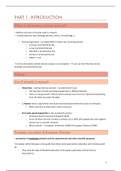Resume
Samenvatting proefdierkunde 1
- Cours
- Proefdierkunde (C004008)
- Établissement
- Universiteit Gent (UGent)
Zeer uitgebreide samenvatting van alle hoorcollege's proefdierkunde 1. Notities zijn zeer uitgebreid en omvatten alles wat de prof heeft gezegd en belangrijk vindt voor het examen. Behaalde resultaat 19/20.
[Montrer plus]












